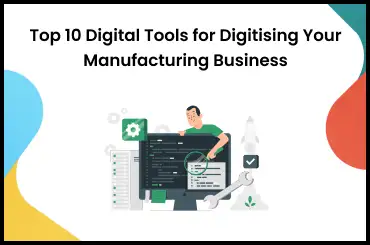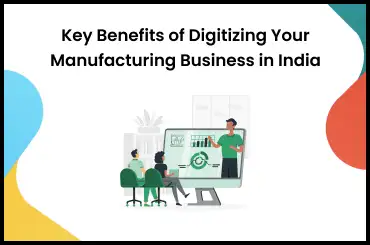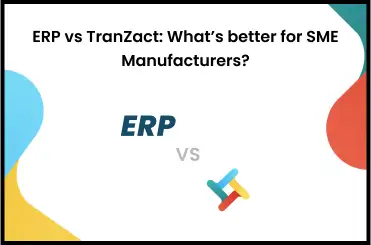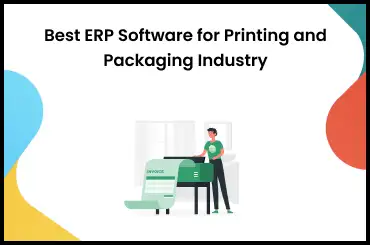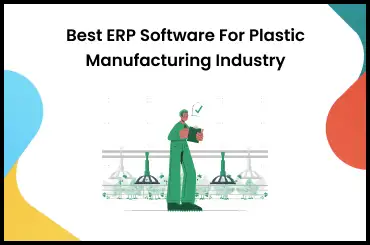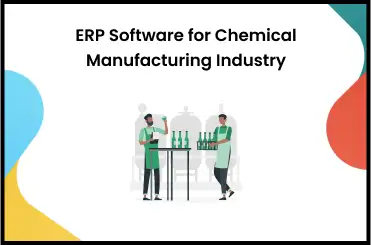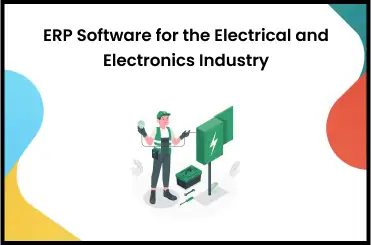You can use ERP software for manufacturing businesses to increase their productivity. But, it is important to conduct a cost-benefit analysis of ERP software before investing in it. When you conduct a cost-benefit analysis (CBA), you can understand if you are making a profitable decision for your company. Cost-benefit analysis of ERP software for manufacturing businesses is easy. Let’s learn to conduct ERP system cost benefit analysis that will help you make informed decisions for your business.
What Is Cost Benefit Analysis Of An ERP System?
ERP system cost benefit analysis is a theoretical process that helps businesses understand whether they are investing in the right software or not. When you conduct a CBA, you figure out all the costs involved in buying and using the software and compare it with all the benefits you will get from the software. One important part of this analysis is the Total Cost of Ownership (TCO). If you are getting ERP software for manufacturing businesses, then TCO will include the purchase price, license costs, training costs, and maintenance costs. In this case, you have to analyze all the benefits of the software and figure out your Return on Investment (ROI). If the Return on Investment is higher than the Total Cost of Ownership, then you are making a good decision for your business. Imagine you run a small manufacturing company in India. You're thinking about getting ERP software to help your business and want to see if it's worth the money. Here's a simple breakdown: First, let's talk about costs.
- Say the ERP software costs Rs.50,000 to buy.
- Setting it up and training your team costs another Rs.5,000.
- Then, it's Rs.1,000 every month to keep it running, and
- Rs.2,000 every year for updates and fixes.
Over three years, this adds up to Rs.97,000. Now, for the benefits.
- This ERP software could help you make 30% more products every month and
- save Rs.2,500 on what you pay your workers.
- Over three years, this could help you earn an extra Rs.100,000 and
- save Rs.90,000 in wages, adding up to Rs.190,000.
So, after three years, using this ERP software could make your business Rs.93,000 better off (that's Rs.190,000 in gains minus Rs.97,000 costs). Plus, it can make your customers happier and your workers less stressed, leading to even more profit.
Costs Involved In Putting An ERP Software Into Place?
To conduct a cost-benefit analysis (CBA), you need to know all the costs involved in implementing ERP software. Here is a detailed analysis of the costs that are involved in putting ERP software.
1. Installation + Subscription Fee
When you want to use ERP software for manufacturing or other businesses, you have to invest money for installation. You may also have to invest money to get a license to use ERP software for manufacturing. If you want to use on-premise ERP, then you have to install hardware and other equipment, too. However, if you want to use cloud-based ERP software, then you have to pay a monthly or yearly fee. You have to include all these costs when you want to conduct a cost-benefit analysis for ERP software.
2. Customization
You can use ERP software for manufacturing according to the nature of your business and team requirements. You need to pay based on the features of ERP software you want to use. If you want to handle more tasks with the help of ERP systems, then you have to invest more. If your business is small and wants to use fewer features, then you can make a small investment.
3. Testing
It is important to test the ERP software for manufacturing for some time before buying them. It can help you understand how fruitful it can be for your business. Testing also helps you identify the features, working process, and other important things and decide if the ERP software fits into your business goals.
4. Training
If you are using ERP software for manufacturing business for the first time, then you have to train your employees. ERP software is based on the technology that your old employee may find difficult to use. However, they can easily learn to operate the ERP system with a little training, but you have to invest some money for this.
5. Maintenance Cost
Software maintenance cost is a factor that you have to consider when implementing an ERP system in your business. You have to pay a fixed amount to your vendor on a monthly or yearly basis to manage the software. The maintenance costs include fixing any problem that occurs within the system.
Key Benefits Of Implementing An ERP System
When you are running a business, your focus should be on making profits. So, you should know the top benefits of implementing ERP system and choose the best erp for manufacturing. Let’s understand the benefits of implementing an ERP system to see if it can help you maximize ROI.
1] Easy Installations And Maintenance
It can take a lot of time and effort to implement a new system in your business, but this is not the case with ERP software implementation. If you choose the best vendor to get the ERP software for manufacturing businesses, then they will take care of everything. Starting from installation to regular updates and ongoing maintenance, you need not worry about it.
2] Real-Time Access
You can have access to real-time data and manage important business tasks with the help of ERP systems. For this, you don’t need to be physically available at your business location to access ERP systems. You can use your smartphone to access real-time data and manage the operations of your business.
3] Integrations
You can integrate an ERP system with other systems or tools in your business to increase output. You can also add several departments and branches of your business on one platform with ERP software for manufacturing business.
4] Reduce Errors
When you use manual methods to manage your business, it increases the risk of human errors. Your employees can also need help communicating and working together. It can help you reduce these errors because it works with accuracy to increase productivity.
5] Customization
You can use ERP software according to your business goals to minimize the complexity of internal processes. You can add more features to the system if needed to manage your business. You can also use only specific functions of ERP software. Thus, ERP implementation can be very helpful to scale up your business.
Utilizing Cost Benefit Analysis: Choose The Best Manufacturing ERP Software
- Understand Your Business Goals: When you want to choose the best ERP software for manufacturing businesses, understand your objectives first. Understand things like whether you want to use ERP software to automate tasks or replace old systems.
- Figure Out The Total Cost Of Ownership (TCO): It is important to conduct a cost-benefit analysis before investing if you want to make a profitable decision. For this, figure out the Total Cost of Ownership (TCO) of the ERP software to conduct a cost-benefit analysis.
- Determine The Benefits: After finding TCO, determine the total benefits of using an ERP solution to conduct a cost-benefit analysis. Further, you have to compare TCO with the total benefits to understand whether you are making a good or bad decision. If the benefits of ERP software are higher than TCO, then it shows that you are making a profitable decision.
- Finalize Terms And Conditions With Your Vendor: It is very important to finalize the terms and conditions with your vendor when you want to have a good relationship and uninterrupted services. Ask the vendors how they will provide maintenance services and what the price for that will be. Find out how frequently they will update the software to the latest version. You can select the best ERP software for manufacturing by following these ERP selection criteria.
Grow Manufacturing Businesses With TranZact
You can improve the productivity of your business with the help of the best ERP systems, especially if you are involved with a manufacturing business. However, it is important to conduct a cost-benefit analysis before investing in ERP software for manufacturing. Above, we have explained the costs involved in using an ERP system for your business. We have also suggested ways to choose the best ERP software. However, an ERP system can be expensive for an SME.
For an Indian SME Manufacturing business, TranZact would be a better choice. TranZact specializes in offering complete software solutions to SMEs, including the best ERP software for manufacturing. Get TranZact right away to access a range of beneficial tools like cloud ERP software, inventory management software, and more. It will help you manage your tasks easily and improve the outcomes of your business.
FAQs
Q1. How to do the cost benefit analysis of ERP?
Cost-benefit analysis of ERP, can be done by figuring out the total cost of ownership (TCO) of the ERP software, which can include installation and subscription fees, maintenance and upgrade fees, employee training, and testing fees. Further, compare it with the total benefits you gain from the investment of your ERP software.
Q2. What is the cost benefit analysis process?
First, you have to figure out the total cost involved in buying and using certain services or products. Further, find out the total benefits you make using that particular tool, software, or things in your business. If the benefits are higher than the investment, you are making a good decision.
Q3. How much does an ERP system cost?
The cost of an ERP system depends on the number of features you use. If you use more features, then you have to pay a higher ERP software cost, and if you use fewer features, then you have to make a small investment.
Q4. What are the keys to successfully implementing an ERP system?
The keys to successfully implementing an ERP system are;
- Identifying the problems within your team
- Make a realistic goal to achieve the expectations with ERP
- Choose the best ERP vendor and understand their offerings
- Customize the software according to your specific needs
- Test the ERP system to confirm if everything goes well
- Training your employees and key people to manage it
Q5. What are the major 5 steps in ERP implementation?
The five major steps in ERP implementation are as follows;
- Planning and identifying your business goals
- Choosing the right service provider
- Customizing the software as per requirement
- Testing the software before investing full money
- Training of the employees
Q6. Why are ERP systems worth the cost?
The following reasons make the ERP system worth the cost;
- It improves the fruitfulness of businesses.
- Provides real-time access to data
- Improve communication between employees
- It can be customized according to industry needsIt helps make better and more informed decisions.








